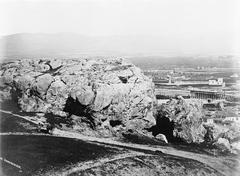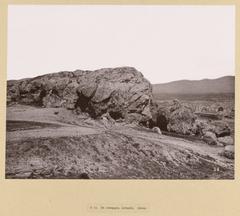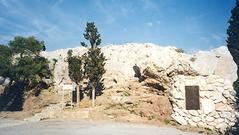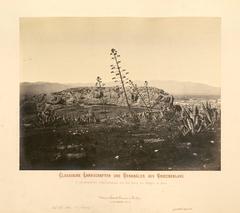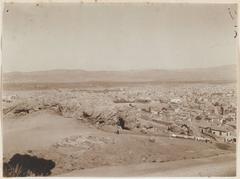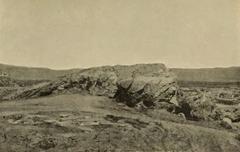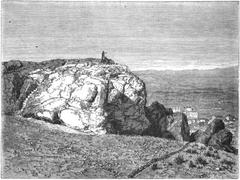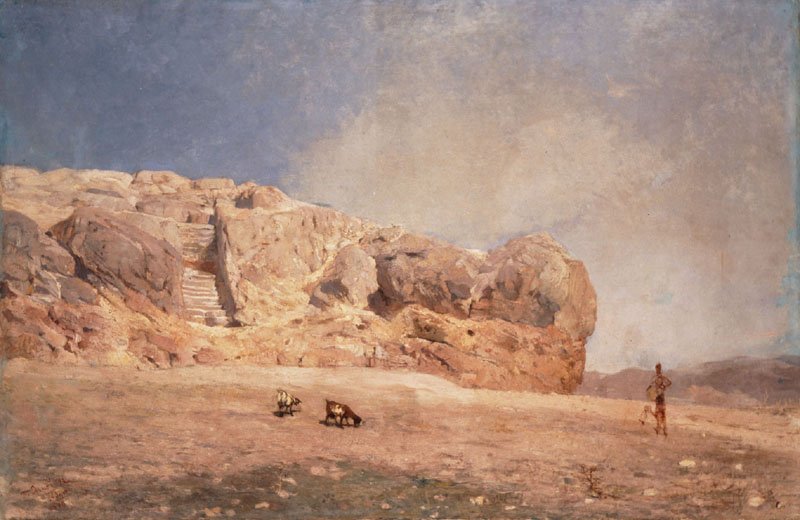
Areopagus Visiting Hours, Tickets, and Guide to Athens Historical Sites
Date: 14/06/2025
Introduction to the Areopagus
The Areopagus, also known as Mars Hill or the Hill of Ares, is one of Athens’ most evocative historical landmarks. This rugged limestone outcrop, located just northwest of the Acropolis, rises approximately 115 meters above sea level and offers panoramic vistas of both the Acropolis and the city of Athens. Renowned for its intertwining layers of ancient mythology, judicial heritage, and Christian significance, the Areopagus stands as a powerful symbol of the city’s rich past.
The hill’s name derives from Ares, the Greek god of war, and it was historically the seat of the Areopagus Council—Athens’ oldest aristocratic and judicial body. This council adjudicated serious crimes such as homicide and religious offenses and profoundly influenced Athenian governance. The Areopagus is also celebrated as the site where the Apostle Paul delivered a seminal sermon around 51 CE, a pivotal moment in the spread of Christianity in Greece.
Today, the Areopagus is an open-air archaeological site that invites exploration. It offers insight into the legal, mythological, and spiritual history of Athens and serves as a vantage point for breathtaking views of the city’s iconic landmarks. This guide covers the site’s history, practical visiting details, travel tips, and nearby attractions to ensure an enriching visit.
For additional resources, see Earth Trekkers, Bible Pure, and Athens24.com.
Contents
- Introduction to the Areopagus
- Origins and Etymology
- Historical and Mythological Significance
- The Areopagus Council: Judicial and Political Roles
- The Areopagus in Christian Tradition
- Archaeological and Physical Features
- Visiting the Areopagus: Practical Information
- Location and Access
- Opening Hours
- Tickets
- Accessibility
- Guided Tours and Special Events
- Nearby Attractions
- Frequently Asked Questions (FAQs)
- Conclusion and Call to Action
Origins and Etymology
The Areopagus (Greek: Ἄρειος Πάγος, “Hill of Ares”) is named after Ares, the Greek god of war (known as Mars in Roman mythology). The hill’s rocky, solid nature is reflected in the term “pagos,” meaning “firm” or “solid.” This natural fortress has been associated with key events in Athens’ history since ancient times.
Historical and Mythological Significance
Legend holds that the gods convened on the Areopagus to judge Ares for the murder of Halirrhothius, son of Poseidon. This mythological trial established the hill’s association with justice—a role it fulfilled as the seat of the Areopagus Council. The council, composed of former archons, served as Athens’ highest court for cases of homicide and serious crimes (Earth Trekkers).
The Areopagus is also featured in Athenian drama, notably Aeschylus’ “The Eumenides,” which dramatizes the trial of Orestes on the hill. Archaeological studies confirm its use as a judicial and deliberative forum from at least the 8th century BCE (Bible Pure).
The Areopagus Council: Judicial and Political Roles
The Areopagus Council wielded significant authority over cases of homicide, arson, and religious offenses. It embodied a blend of civic and divine law, with decisions considered final and binding (Christian Publishing House). The council’s influence fluctuated over time—its political power peaked in the early classical period but was curtailed by democratic reforms under Ephialtes in 462 BCE. Nevertheless, the council retained its role in homicide cases and continued to function into the Roman and early Byzantine eras.
The Areopagus in Christian Tradition
The Areopagus is renowned in Christian history for the Apostle Paul’s sermon, recorded in Acts 17:16–34. During his missionary journey, Paul addressed Athenian philosophers—introducing Christian doctrine by referencing their altar “To an Unknown God.” His speech marked a turning point in the spread of Christianity, engaging the Greco-Roman world on its own philosophical terms (Bible Pure; Christian Publishing House).
A bronze plaque near the foot of the hill commemorates Paul’s sermon. The nearby Cathedral Basilica of St. Dionysius the Areopagite is named after one of Paul’s convert listeners, further underlining the site’s Christian heritage.
Archaeological and Physical Features
The Areopagus is a rugged marble outcrop, shaped by natural erosion and centuries of human use. Visitors can see:
- Rock-cut steps and benches: Used by council members and public attendees during legal proceedings.
- Shallow depressions and postholes: Evidence of temporary structures such as awnings.
- Lack of permanent buildings: The tradition of open-air deliberation remains evident (athens24.com; travelcurious.com).
- Panoramic views: Overlooking the Acropolis, Ancient Agora, and central Athens.
Systematic archaeological investigation has documented the adaptation of the hill for civic gatherings and preserved its features as part of Athens’ protected archaeological zone.
Visiting the Areopagus: Practical Information
Location and Access
- Location: Northwest of the Acropolis, Athens 105 58, Greece.
- Reaching the Site: Access the hill via stone steps from the pedestrian path encircling the Acropolis (Around Greece).
- Public Transport: Nearest metro stations are Acropoli (Line 2) and Monastiraki (Lines 1 & 3).
Opening Hours
- General Hours: Open daily, typically from 8:00 AM to sunset.
- Note: The site is open-air and can be visited at any time, but daylight hours are safest and most rewarding (Around Greece).
Tickets
- Admission: The Areopagus is free to enter and does not require a ticket.
- Combined Tickets: While access is independent, visitors often combine it with a ticket to the Acropolis and other archaeological sites for a fuller experience (Live the Greek Life).
Accessibility
- Terrain: The hill is rocky and uneven; sturdy footwear is essential.
- Mobility: Not fully accessible for those with mobility impairments, as there are no railings and the steps can be slippery (Athens24.com).
- Restrooms and Facilities: None on-site; facilities are available at the Acropolis entrance or nearby neighborhoods.
Guided Tours and Special Events
- Tours: Many guided tours—historical, archaeological, and Christian-themed—include the Areopagus (The Crazy Tourist).
- Events: Occasional public lectures and events are held, especially during cultural festivals.
Safety and Preservation
- Surfaces: Exercise caution, especially after rain.
- Preservation: Remain on designated paths and do not climb on fragile areas (Greek Ministry of Culture).
Best Times to Visit and Photography
- Best Times: Early morning or late afternoon for cooler temperatures, thinner crowds, and the best light for photography.
- Views: Capture sweeping panoramas of the Acropolis, Ancient Agora, Mount Lycabettus, and Athens’ skyline.
- Photography: Encouraged, but drones require special permission.
Nearby Attractions
- Acropolis and Parthenon: Athens’ most famous ancient monument (Dark Green Adventures).
- Ancient Agora: The civic heart of ancient Athens.
- Acropolis Museum: Modern museum with artifacts from the area.
- Plaka and Anafiotika: Historic neighborhoods with cafes and shops.
- Cathedral Basilica of St. Dionysius the Areopagite: Christian heritage site.
Frequently Asked Questions (FAQs)
Q: What are the Areopagus visiting hours?
A: The site is open 24 hours, but visiting during daylight is recommended.
Q: Is there an entrance fee for the Areopagus?
A: No, the Areopagus is free to enter with no ticket required.
Q: Is the site accessible for people with mobility issues?
A: Accessibility is limited due to uneven, rocky terrain.
Q: Are guided tours available?
A: Yes, many Athens tours include the Areopagus.
Q: Are there restroom or food facilities on-site?
A: No, but facilities are available nearby.
Rules and Visitor Etiquette
- Stay on paths: Protect the site by staying off fragile areas.
- No littering: Carry out all trash.
- Quiet respect: Maintain a respectful atmosphere.
- Dress appropriately: Wear suitable attire for a historic site.
Summary and Key Points
The Areopagus embodies Athens’ enduring legacy of law, mythology, and spirituality. As the ancient seat of the Areopagus Council, it highlights Athens’ innovations in governance and justice. Its association with the Apostle Paul’s sermon marks a crossroads of philosophical and religious history. The hill’s free, open access and spectacular views make it a must-visit, while its proximity to other major sites enables a rich, multifaceted exploration of Athens’ past.
For historical details, practical tips, and updates, refer to official resources such as the Greek Ministry of Culture and travel guides like Around Greece and The Crazy Tourist.
Call to Action
Ready to experience the Areopagus and Athens’ ancient wonders? Download the Audiala app for the latest visitor information, curated tours, and travel inspiration. Follow us on social media for updates on historical sites, special events, and exclusive travel tips.
Sources
- Visiting the Areopagus in Athens: History, Tickets, and Travel Tips, 2025, Audiala Travel Guide
- Discover the Areopagus in Athens: Where Ancient History Meets Christian Heritage, 2025, Bible Pure & Christian Publishing House, Christian Publishing House
- Visiting the Areopagus in Athens: History, Tickets, Hours, and Travel Tips, 2025, Athens24 & Travel Curious, Travel Curious
- Areopagus Visiting Hours, Tickets, and Tips for Exploring Athens’ Historic Hill, 2025, Around Greece & Greek Ministry of Culture, Greek Ministry of Culture
- The Crazy Tourist, 2025, Best Things to Do in Athens
- Earth Trekkers, 2025, Best Things to Do in Athens, Greece
- Live the Greek Life, 2025, Opening Times and Entrance Fees of Athens’s Most Popular Landmarks
- Dark Green Adventures, Things to Do in Athens, Greece

